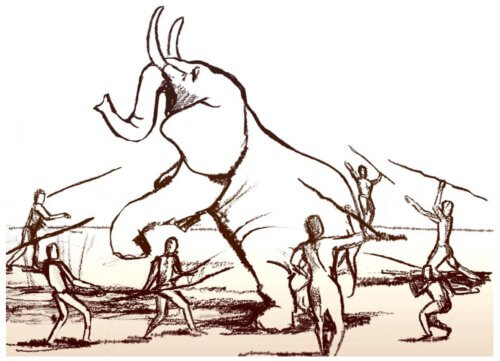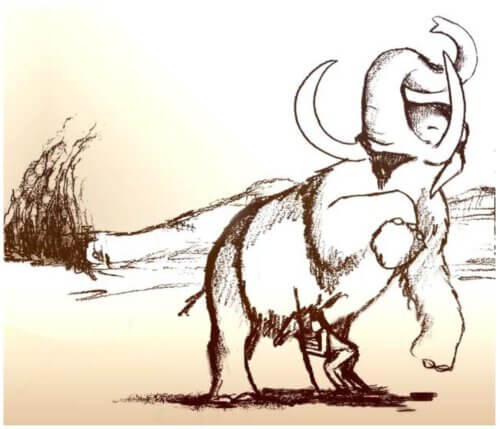A new article by Dr. Miki Ben Dor and Prof. Ran Barkai, researchers from the Department of Archeology offers a unifying explanation for the accumulated physiological changes and the social behavior of humans since the appearance of humans about two million years ago until the agricultural revolution

A new article by Dr. Miki Ben Dor and Prof. Ran Barkai, researchers from the Department of Archeology named after Yaakov M. Alkov at Tel Aviv University, offers for the first time a unified explanation for the physiological, behavioral and cultural evolution of the human race, from the beginning of man's appearance about two million years ago until the agricultural revolution. According to the article, man evolved as a hunter of the large animals and thus caused their extinction. The adaptation to hunting small and agile animals was manifested, among other things, in the development of a high cognitive ability, as observed in the most prominent evolutionary change - the increase in brain volume from 650 cc to 1500 cc. So far, no unifying explanation has been offered for the central phenomena of human prehistory. The innovative theory was published in the journal Quaternary.
In recent years, more and more evidence has been accumulated and according to which man was a major factor in the extinction of the large animals, which forced him to gradually switch to hunting smaller animals, initially in Africa and then in all other parts of the world. In Africa, the average size of land mammals was close to 500 kg 2.6 million years ago, at the beginning of the period in which man developed, while before the transition to agriculture the average size was only a few tens of kg - a decrease of over 90%.
Beyond hunting small and agile animals
According to the researchers, the decrease in the size of game animals and the transition to hunters of small and agile animals forced man to be sophisticated and bold, an evolutionary process that resulted in an increase in the volume of the human brain, and later also in the development of a language that would allow the exchange of information regarding the whereabouts of the prey. According to the theory, all the measures are intended for one purpose: efficiency and saving in the body's energy expenditure (energy saving).
The researchers show that the early man was, for most of his development, a super carnivore, specializing in hunting large animals. Since they made up most of the biomass available for hunting, the animals provided him with a high level of fat, an essential source of energy for man, and just as importantly - enabled a higher energy return than hunting small animals. In the past there were six different species of elephants in Africa and they accounted for over half the biomass of the herbivores hunted by humans. Preliminary evidence from East Africa shows that Homo sapiens appeared there only after a significant decrease in the number of elephant species in certain areas. In the comparison of the size of the animals conducted by the researchers between archaeological cultures representing different human species in East Africa, Southern Europe and Israel, a significant decrease in the frequency of animals weighing over 200 kg was found in all cases, along with the increase in the volume of the human brain.

A direct connection between the increase in brain volume and the need to improve as a hunter
"We link the increase in the volume of the human brain to his need to improve as a hunter," explains Dr. Ben Dor, "the need to hunt, for example, dozens of deer instead of one elephant created a continuous evolutionary pressure on the functioning of the human brain, which now requires the hunter to invest much more movement and mental energy . Hunting small animals, which are frequently threatened by predation and usually run away very quickly, requires a suitable physiology for the chase and more complex hunting tools. Mental activity also increases. Fast tracking requires quick decision-making based on phenomenal knowledge of the animals' behavior - knowledge that needs to be stored in a larger memory"
"The evolutionary adaptation of the human family was very successful," says Dr. Ben Dor. With the continued decrease in the size of the animals, the invention of the bow and arrow and the domestication of the dog enabled more efficient hunting of medium and small animals - until their population also dwindled. Towards the end of the Stone Age, with a further decrease in the size of animals, a situation arose in which it was necessary to invest more energy in hunting, than could be received in return. And really at this stage the agricultural revolution and the domestication of animals and plants took place. Simultaneously with the transition to permanent settlement and agriculture, our brains shrunk in size (to its current size of 1300-1400 cc) since there was no longer a need to assign wonderful cognitive abilities to hunting, since domesticated plants and animals do not run away."

"Humans brought this on themselves"
Prof. Barkai: "While the chimpanzee's brain, for example, remained stable for seven million years, the human brain grew threefold during that period - and reached its peak about 300,000 years ago. In addition to the volume of the brain, the evolutionary pressure brought man to use language and more complex tools, such as the bow and arrow, to adapt his shoulders and arms for throwing and throwing, to adapt his body for continuous pursuit in the field, to perfect the stone tools, to control fire, to domesticate the dog and finally also to domesticate the hunting itself and move to agriculture".
Prof. Barkai adds: "You have to understand that our perspective is not deterministic. Humans brought this trouble upon themselves. They focused on hunting the largest animals, until they drove them to extinction. Wherever man has arrived - no matter if it is Homo erectus or Homo sapiens - we see sooner or later a mass extinction of large animals. Hanging on to the big animals had a price. The man cut himself the branch he was sitting on. While other species would have become extinct with the extinction of their prey, such as our Neanderthal brothers for example, Homo sapiens cut the branch for itself and decided to plant a new tree, that is, to switch to agriculture."
More of the topic in Hayadan:
- Israeli researchers have found the earliest animal fat discovered so far on flint vessels half a million years old
- Humans are not selfish by nature - we are actually built to work together
- The super carnivore monkey
- A study of skeletons in Syria and a comparative genetic study of populations reveals: the Neolithic brought agriculture and culture from the Fertile Crescent to Europe by sea

8 תגובות
"...man evolved as a hunter of the large animals and thus caused their extinction..."
I was too weak to stand up to the professional scientists.. but as far as I know, what caused their extinction were the climate changes that took place and the depletion of food and water sources
Lasaf, like in too many places (especially on the net less face to face) you answer to the body of a writer and explain how good and perfect you are and the other is screwed. But you don't answer the claims.
When I saw that there was a response I was waiting for a bite that would make the discussion more interesting but also for reference. Instead you chose to fight over who has the bigger one. Good.
To: Nitzan:
If you were content with "I don't understand" Dino,
Because as someone who does understand, knows and is interested, I wrote my response
After reading the original article,
The translation of "a popular science site", reliable and accurate,
Therefore, as you wrote, "a little modesty" will not hurt
Especially for those who continue to write that:
"No one knows" ,
It's a shame that later on you are thinking about things
It's not just that you don't know
but also far from reality,
In other places I wrote that:
"End of response in reading comprehension",
Whatever the situation in your response,
Too bad …
Asaf, the "wrong!" Yours is wrong!!!
I just don't like deterministic assertions especially about a subject that no one really knows. For the simple reason that no one was there. A little modesty never killed a cat.
I don't understand at all the hunting techniques and the appearance of the weapons but if the figure of the average size of the mammals dropping is really in sync with the claim of the researchers then you are wrong. The luck of the animals in Africa was that they evolved at the same time as man and therefore learned to fear him.
The giraffes, rhinos and elephants you see today are the descendants of the three individuals who learned to hide properly... drinking raspberry juice. And if it is still not clear, I will be happy to expand. But that's secondary.
The mass extinction that took place outside of Africa happened because the man who arrived there had an (evolutionary) fur on the animals there.
The talk about religions and customs of the animal groups is not relevant today, but maybe it is customs left over from the time when there were few large animals and today *maybe* it is much more dangerous to hunt an elephant than 50 deer, I don't know. Especially with the new cognitive ability.
And finally = there are several theories for brain growth, time will tell which one is correct... I wouldn't rule out any of them based on a translation on a popular science website, no matter how good it is.
Man causes the elimination of the balance in nature, the extinction of species for systematic and even industrial abuse (see the meat, milk and egg industry) of all creatures that are inferior to him in their intellectual level. In the end, as history teaches, man causes harm to himself.
Man treats other creatures with disdain, even giving them disrespectful names such as: beast, beast.
Man even embeds this disparaging attitude in his religion and belief - the animals were created for man. It's like once upon a time the black man was created to be the white man's slave. But the black man has a mouth to shout, he has the power to organize, the animals do not have these abilities.
So it is allowed to kill animals for food, this is how nature itself works and the suffering of the animal is minimal when it is killed quickly (we will all die one day). But it is forbidden to raise an animal in bad conditions such as: denying space, imposing deformities, denying play, denying food, transporting in the blazing sun and extreme cold, horrific experiments for the cosmetics industry, stripping animals of their skin while they are alive, turning animals into walking robots that move only by Orders (horses, elephants).
More details on the site https://animals-now.org
And on my website: https://eisaak123.wixsite.com/animals
Eli Isaac is a private tutor for programming up to a master's degree
https://eisaak123.wixsite.com/privatelessons
Continue to my response:
The San ("Bushmen") in southern Africa hunt only small animals,
So are the Pygmies in Central Africa,
Even the Maasai who are considered warriors and hunters
Engines hunting large animals (because of their religion)
and hunt only animals that cause them and their herds harm,
The only large animal that the Maasai religion allows hunting
She is the Island ("Kana") because of her "imagination" to visit.
Despite the huge herds of deer in Africa
Hunting deer herds was developed in Asia, not Africa.
Do the researchers claim that the minds of Africans are different?
Do the researchers claim differences between an American's brain
From the 14th millennium BC and the mind of a resident of Papua?
attribute the extinction of large mammals in (North) America
in Europe and Asia for climate change and people's help,
But the attributed "help" is minimal.
There is no doubt that human society seriously damages the natural environment,
There is no doubt that since the development of firearms, thousands of large mammals have been murdered,
But for the relation of brain size to the extinctions of large mammals in the past
It's an abstraction of a complicated situation...
Prof. Barkai: "While the chimpanzee's brain, for example, remained stable for seven million years, the human brain grew threefold during that period - and reached its peak about 300,000 years ago.
What is the explanation for the chimpanzee's brain remaining stable?
Not true !
since until the development of tools for killing from a distance such as a bow and arrow or a lance
Early human species were unable to hunt large animals
and were fed mainly by picking and collecting fruits and roots,
The meat food was given to laggards that were hunted by carnivores,
To this day there are groups in Africa that are engaged in exterminating lions
from a carnivore to steal the meat,
Anyone who has accompanied groups of hunter-gatherers knows that they are
Large animals will not attack even though they have weapons to kill from a distance,
Only when the Neanderthals and Homo sapiens came out of Africa
A hunter of large animals became a source of energy
Indeed they have a part in the extinction of large animals in Europe,
Asia, and the American continent in particular.
The presence of giraffes, elephants, rhinoceroses and more on the African continent
contradicts the researchers' conclusion...